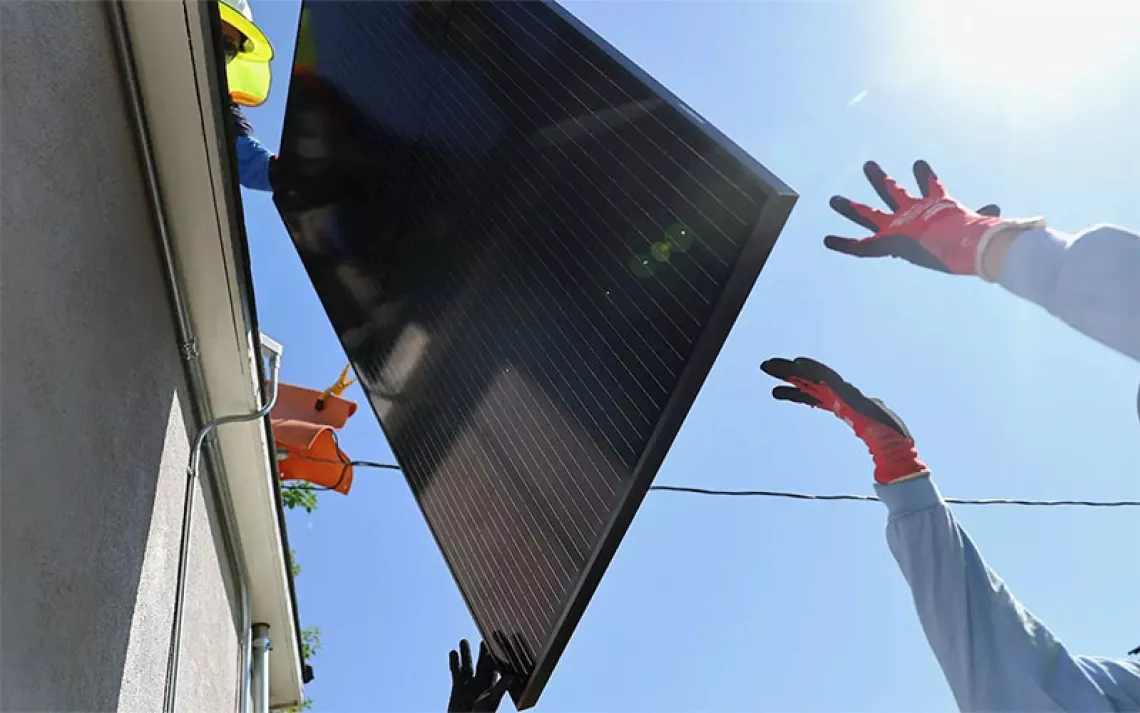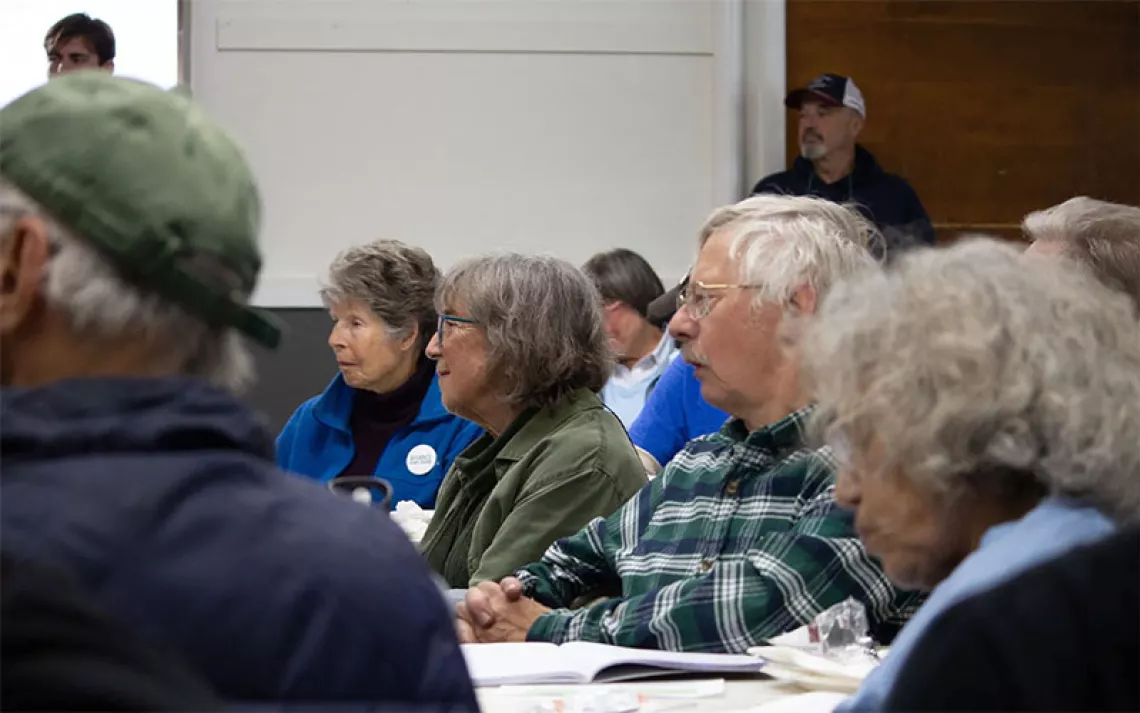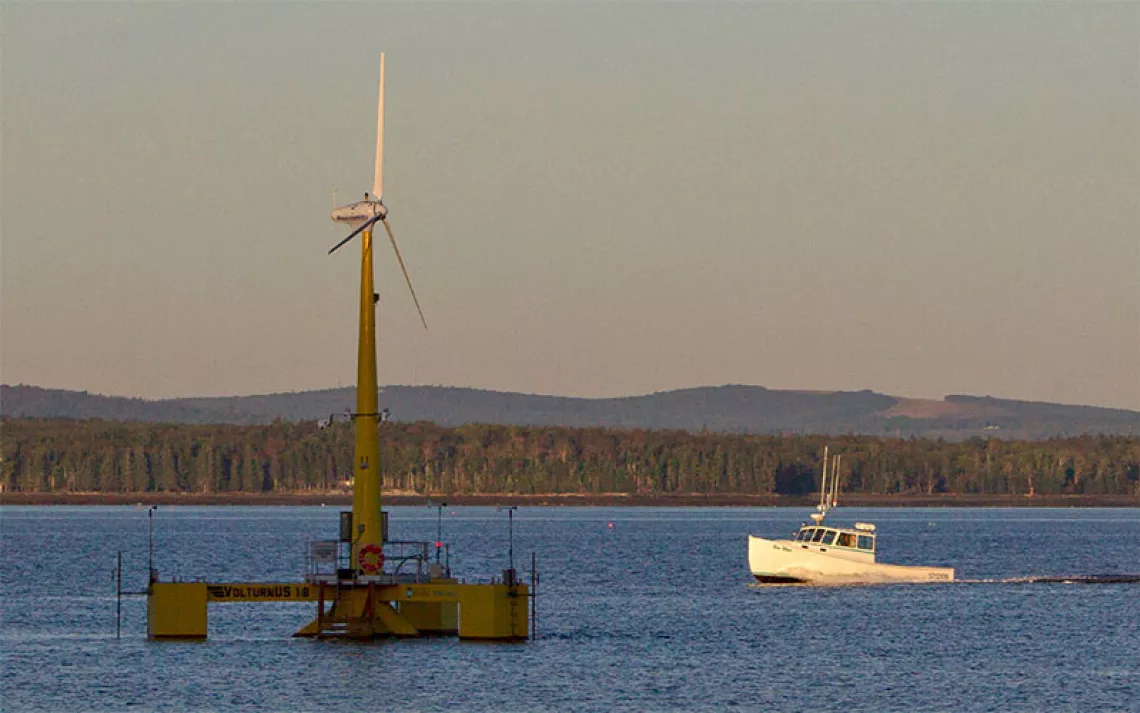Turbulence Rattles the Northeast's Nascent Offshore Wind Industry
Tradeworkers are left hanging as offshore wind ambitions collide with industry woes
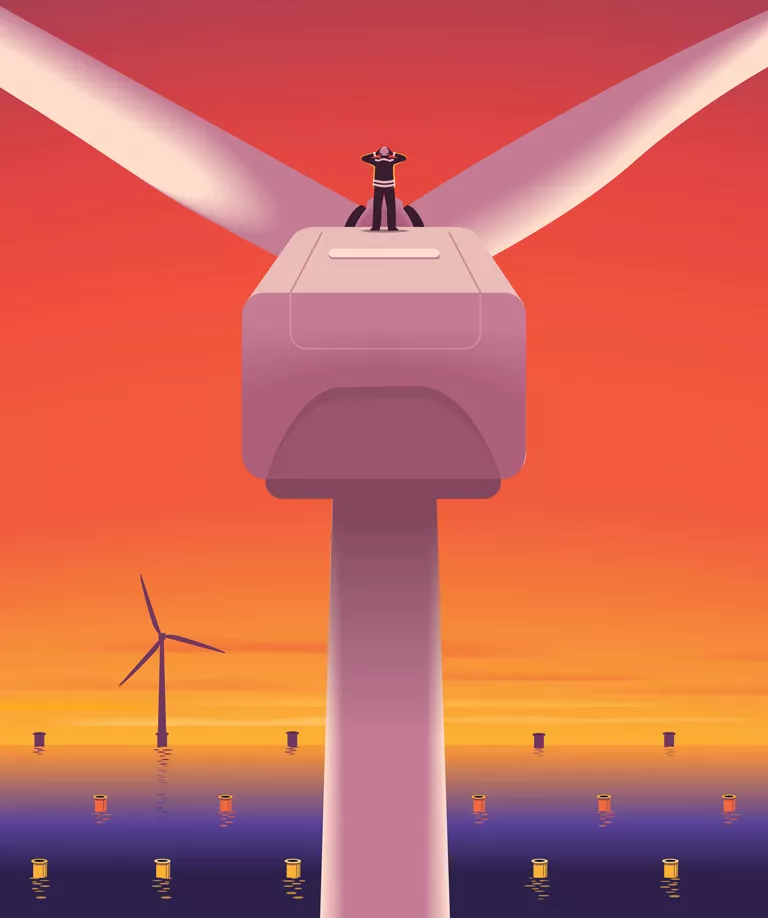
IN LATE SUMMER 2023, Mike McHale was feeling optimistic about the future of offshore wind in the Northeast. As the business manager for an electrician’s union in Maryland, he watched about 30 of his members report for work each day at Tradepoint Atlantic, a sprawling waterfront manufacturing complex southeast of Baltimore. They were building the components for Ocean Wind 1, New Jersey’s first offshore wind farm.
“We’ve just been waiting, waiting, waiting for work to start,” the 58-year-old Baltimore native said last year, barely containing his glee, “and now it finally has.” Alongside the electricians were union ironworkers, carpenters, and laborers fabricating and assembling turbine platforms, pilings, boat landings, and ladders at the 40-acre site. The components were being manufactured by Ørsted, a Danish energy company that’s become a global leader in offshore wind development.
At the time, McHale was expecting to send even more electricians to additional Ørsted manufacturing sites planned for Tradepoint Atlantic (TPA), while another company, US Wind, had announced plans to build the steel bases, called monopiles, that hold offshore wind turbines upright. In total, the future projects, plus an additional steel plant—full of wiring and heavy machinery that must be maintained—would need “at least 50 electricians right off the bat,” McHale figured. “And that’s just the onshore portion.”
Between them, Ørsted and US Wind had plans to develop three wind farms off the coast of Maryland. The projects would create thousands of jobs for those in the trades. They would be crucial to meeting Maryland’s ambitious offshore wind goal, set when Democratic governor Wes Moore signed the Promoting Offshore Wind Energy Resources (POWER) Act into law in April 2023. Under the law, the state committed to producing 8.5 gigawatts of offshore wind power—enough to keep the lights on in 3 million homes. All told, it would account for over a quarter of the Biden administration’s offshore wind power target: 30 gigawatts by the end of the decade. By fall 2023, industry leaders and advocates in Maryland were talking about offshore wind like it was an inevitability, a modern-day gold rush.
Then, on Halloween, the bubble burst. Ørsted canceled its Ocean Wind 1 project plus another New Jersey wind farm that was in the works called Ocean Wind 2. The electricians working at TPA were laid off and were out of work within a week. These projects were two of at least four offshore wind projects nixed in the Northeast during the latter half of 2023. Even before the cancellations, experts at BloombergNEF, an energy research company, were predicting that just 16 gigawatts of offshore wind would be installed in the United States by 2030.
Thanks to clever policy innovations and a willing workforce, Maryland once seemed better positioned than any other state to hit its ambitious clean energy goals. But now those ambitions are colliding with the headwinds of an industry in trouble. In the meantime, trade workers like McHale are stuck in limbo. When McHale tried to round up some laid-off union members to talk to me about their experience at TPA, he found no takers. They were worried about coming off too negative, he told me later.
“I believe in climate change. I believe it’s happening,” McHale said. “But I have a hard time in certain conversations explaining to members that fossil fuels are an issue when they’re not working.”
THERE'S PERHAPS never been a more pivotal time to develop offshore wind energy. In addition to its need to quickly scale down carbon emissions to curb global warming, the United States is forecast to see a surge in demand for new power, due to the data centers and internet infrastructure needed to support artificial intelligence and cloud computing. And yet, there has perhaps never been a more difficult time to try to build out a brand-new energy sector from scratch. Historic inflation driven by the pandemic and global conflicts have led to skyrocketing construction prices. Since 2019, the cost of doing business in the offshore wind industry has increased by nearly 40 percent. Wind farms are multibillion-dollar projects that often require financing, so even the slightest uptick in interest rates can quickly tip a project into the red.
Jeremy Firestone, a professor of marine science and policy at the University of Delaware, said it’s a problem not unlike the one potential homebuyers face. “When you take out a mortgage, there’s a huge difference between being able to borrow at 4 percent or 8 percent. And if you’re borrowing a billion dollars, that really changes the project economics just the way it would for people who are looking to buy a home.”
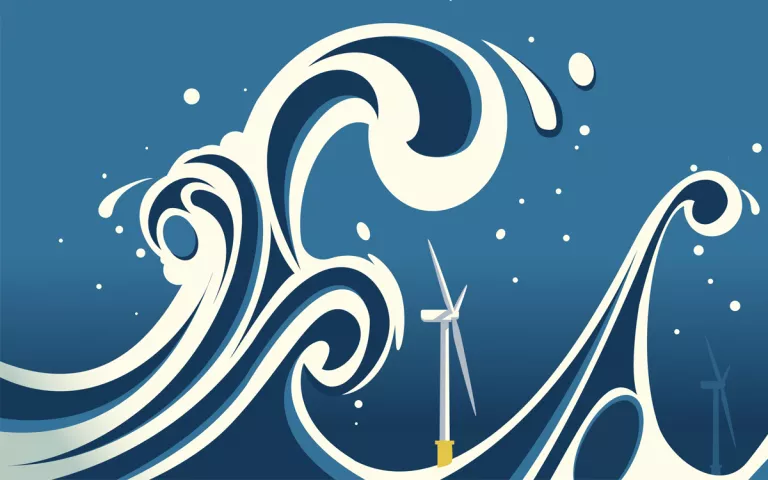
Another hurdle is the gauntlet of approvals and permits that developers have to secure before they can even begin to source the steel to make the wind turbines. Offshore wind farms are staggeringly complex projects, often with dozens of turbines taller than the Statue of Liberty and blades as long as football fields twirling above the open ocean. To ensure feasibility, safety, and the well-being of the marine ecosystems, these projects typically require years of review and permitting.

Sign up to receive Sierra News & Views
Get articles like this one sent directly to your inbox weekly.
With this action you affirm you want to receive Sierra Club communications and may vote on policy designated by the Sierra Club Board.
The Bureau of Ocean Energy Management, the federal agency that manages energy projects on the Outer Continental Shelf, issues leases and approves construction plans, while other aspects of the projects must be approved by a long list of federal players, from the Coast Guard to the Fish and Wildlife Service to the Army Corps of Engineers.
“We need to try and think about how to make this process a little bit more straightforward,” said Rebecca Barthelmie, a professor of mechanical and aerospace engineering at Cornell University. In Germany, for example, a single agency handles offshore projects and has a fixed permitting timeline.
To make matters worse, wind-energy companies are struggling to train and hire workers in a tight labor market. According to the Department of Energy’s National Renewable Energy Laboratory, more than 44,000 workers will be needed to hit Biden’s 30-gigawatts-by-2030 goal, from constructing monopiles to piloting crew transport vessels. But in 2022, the sector had roughly 1,000 workers. More than two-thirds of wind companies have reported difficulty finding qualified employees.
Even when a company can gather the workforce to begin construction, supply-chain issues have left materials in short supply. In Albany, New York, construction on a factory that will one day roll five-inch-thick steel plates into turbines has stalled. Meanwhile, the few companies that manufacture the souped-up cables wind farms need to connect with the grid are backlogged with orders. It’s a chicken-and-egg dilemma: To green-light construction on a wind farm, energy companies need components, but to invest in factories to make components, manufacturers need approved wind farms.
Developers are also running up against an obscure piece of maritime legislation called the Jones Act. The century-old law requires an American-made ship to transport materials from shore to the construction site, but the United States is currently without a wind turbine installation vessel. As its name suggests, this type of ship is specially designed to carry the gargantuan components of a wind turbine and also serve as a construction platform. Developers in the US are forced to use much smaller, domestically produced barges, making an already slow process much slower.
Despite the obstacles, some major offshore wind projects have succeeded. In October 2023, just hours before Ørsted axed its farms in New Jersey, Virginia-based utility Dominion Energy made a triumphant announcement: The Department of the Interior had granted its final approval of the $9.8 billion Coastal Virginia Offshore Wind project, slated to be the largest wind farm in US waters. According to Dominion, when the project is completed, its 176 turbines will produce 2.6 gigawatts of energy a year, enough to power 660,000 homes. One of the keys to Dominion’s success? It’s building its own wind turbine installation vessel.
Up and down the Northeast, it appeared that offshore was starting to set sail. In December, the first turbine in New York’s South Fork Wind began sending electricity to the mainland through an undersea cable. A month later, the blades started turning at Massachusetts’s Vineyard Wind off Martha’s Vineyard. When the two farms are fully built out, they will provide power to nearly half a million homes.
“We’re American. We can make anything happen. If Liberty ships were built here, we surely can make some monopiles.”
But for every encouraging headline offshore wind generates, it seems bad news is never far behind. Along with Ørsted’s scrapped farms in New Jersey, three projects in Massachusetts and Connecticut were canceled in 2023, wiping out nearly one-fifth of Biden’s gigawatt goal. Meanwhile, in Norfolk, Virginia, Siemens Gamesa reneged on a planned turbine-blade manufacturing facility, which had promised hundreds of jobs. Last fall, developers of four proposed wind farms in New York asked the state for an additional $12 billion in subsidies and were denied. The New York State Energy Research and Development Authority agreed to pay higher prices for electricity for three of the projects, but in April the agency scuttled those contracts after renewable energy manufacturers canceled plans to build larger wind turbines. The state would have needed to purchase smaller turbines in a larger quantity, ballooning costs. Now the state and offshore wind developers are at an impasse.
In January 2024, Ørsted officially exited its agreement with Maryland to sell power from its planned offshore wind farms in the state, calling the deal “no longer commercially viable because of today’s challenging market conditions.” While advocates remain optimistic—the state and the energy company could broach a new deal, and Ørsted said it would continue with the permitting process—the way forward remains unclear.
It is this seesaw between dispiriting setbacks and dogged determination that typifies attitudes in Maryland. Jamie DeMarco, the federal policy director at a Maryland-based nonprofit called the Chesapeake Climate Action Network, said he’s not surprised by the starts and stops.
“Any time you have a mass adoption of a new technology, there are individual projects that will fail,” he argued. “At the same time, we’re having more offshore wind come online than ever. Blades are spinning. Electricity is being generated.”
Yet the ups and downs are still taxing for McHale, who is responsible for securing contracts with wind companies for union members—in other words, finding jobs for his fellow electricians. “You’re trying to reposition yourself to go after the green work,” McHale said, but then the work often doesn’t pan out.
LORIG CHARKOUDIAN, the state delegate who cosponsored the POWER Act, believes the law can insulate Maryland from many of the challenges facing the industry right now, especially since the state government has committed to buying the power to fulfill its own energy needs. Most energy companies have to find their own customers through power-purchase agreements, long-term contracts that remove some of the financial risks for the developers. In Maryland, however, “the state will guarantee whatever price the developer needs to do the building,” Charkoudian explained. “That means we have a good bit of flexibility going forward.”
Additionally, the POWER Act tasks the Maryland Public Service Commission with investigating the potential of a single transmission line that wind farms can plug into. Or, as DeMarco put it, “to run one extension line, put out a power strip, and let everyone plug into it.” Instead of each company building its own line, the state will do it for them, cutting down on duplicative infrastructure that’s required of most utility projects. It’s these policy innovations that keep DeMarco hopeful. “The POWER Act really was a big deal of a bill,” he said.
As Ørsted reevaluates its projects in Maryland, one developer is still looking to take advantage of the new legislation. US Wind has doubled down on its commitment to helping the state reach its clean energy goals while working to shake loose the supply-chain bottleneck currently hampering the industry.
These days, the site of US Wind’s planned monopile manufacturing facility, Sparrows Point Steel, resembles a postcard of industrial decay. Situated on the southeast side of TPA—overlooking a swell in the Patapsco River where Francis Scott Key peered out from a British warship in 1814 to see that the star-spangled banner did, in fact, yet wave—the future offshore wind hub is studded with abandoned warehouses and orphaned cranes.
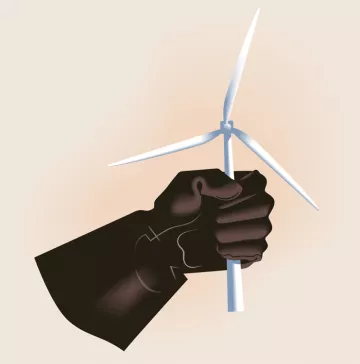
But within a few years, predicted Nancy Sopko, senior director of public affairs at US Wind, Sparrows Point Steel will be “a bustling hive of economic activity,” where monopiles will be made for US Wind’s two Maryland wind farms and other companies’ projects up and down the East Coast. In November 2023, the US Maritime Administration awarded Baltimore County and Sparrows Point Steel a $47 million grant to rehab the property. “The grant money is going to be critical to . . . get the site ready,” Sopko said. “The site has been dormant for over 20 years, so it needs a good amount of cleaning and design work . . . reinforcements to the ground . . . reinforcements to the dry dock.”
A week after my call with Sopko, I stood on the edge of that dry dock, which looks like a massive concrete swimming pool. At 5.5 acres, it’s one of the largest dry docks on the East Coast. Next to me was Teaera Strum, who’s hoping her family-owned welding and fabrication firm, Strum Contracting, will be chosen to complete some of those reinforcements. A monopile can weigh as much as four fully loaded Boeing 747s. “None of this can support the monopiles right now,” Strum said, pointing into the dock. “If they were here, they would literally sink into the ground.”
In 2019, Strum Contracting was tapped by US Wind to make similar port enhancements to another berth at TPA. Strum used the opportunity to partner with a local workforce development nonprofit that trains people in the community for manufacturing jobs, ultimately hiring seven new workers (in addition to her staff of 30) for the project, some of whom had been previously incarcerated. “[These jobs] almost allow us to re-create the working class,” she said.
For Strum, taking care of her community means not just creating good-paying jobs but also protecting it from the impacts of global warming. Last summer, her crews were unable to work for days because of unsafe air from Canadian wildfire smoke. She believes investment in clean energy like offshore wind is paramount for both the local economy and the future of the planet. Strum knows that she can’t stop climate change alone, but she can help slow it down. She believes Maryland is doing everything it can to be on the right side of history. “Don’t get me wrong though,” she said, “It’s like waiting for paint to dry.”
Sopko said that US Wind remains “very, very committed,” to its projects in Maryland. The company’s first planned wind farm, MarWin, already has a draft environmental impact statement, and she hopes the project will get final approval by late 2024. Still, she said, it’s difficult to imagine the 22-turbine wind farm coming online by 2025, the company’s original goal.
As for Sparrows Point Steel, the schedule is even murkier. While US Wind’s own wind farms will be the anchor customers, the steel manufacturer will need a lot more demand than that to become operational. “To build a thriving business there, we need orders from other developers, to build components for their projects,” Sopko explained. “Seeing the headlines of project cancellations, project delays, or companies pulling out of states—we have to remain flexible as well.”
Sopko likened the situation to “trying to build the plane as you fly it.” If anyone would like things to move quicker, it’s Strum. But when considering the scale needed to get offshore wind in the Northeast up and running, she reflects on the history of steelmaking in Baltimore, where workers built 384 Liberty ships during World War II.
“We’re American. We can make anything happen,” she said, “If Liberty ships were built here, we surely can make some monopiles.”
THERE IS ONE PLACE in Maryland where wind turbines are already spinning over the Atlantic Ocean—inside a 40-foot, 360-degree simulator at the Maritime Institute of Technology and Graduate Studies (MITAGS) in Linthicum Heights, just south of Baltimore. In the rush to scale up an offshore wind workforce, institute staff hope the simulator will play a role in training workers in the industry.
Since 2021, the institute, a nonprofit vocational training center, has been inviting mariners—everyone from Coast Guard captains to crab-boat operators—to visit and learn what it would feel like to navigate through Ørsted’s now-canceled Ocean Wind 1 farm by stepping inside its hyper-realistic simulator. Ørsted partnered with MITAGS to develop and operate the wind farm simulator, according to Catherine Gianelloni, the center’s East Coast academic director and my tour guide the day I went to see it for myself. Prior to the partnership, the only way a maritime professional could experience a wind farm would be by flying to Europe and getting on a boat.
It was a little surreal to step from the institute’s nondescript, fluorescent-lit hallway into what appeared to be the cavernous bridge of a cargo ship, the gray Atlantic before, beside, and behind us. Four casually dressed mariners stood before rows of instruments and illuminated buttons.
Gianelloni said that the mariners her organization serves, among them Maryland’s commercial fishermen, still have a lot of questions about how offshore wind will affect their bottom lines. If they can’t catch fish near the wind farms, they won’t make money. “People are concerned. They want to know, ‘Can I really fish in here? . . . Can I drag my nets?’” Gianelloni said. “They can come practice here; we actually have nets!” The school has a library of more than 700 different vessels that participants can take for a spin in the simulator, including a submarine.
But far from simply promoting acceptance and understanding of the long-promised offshore wind boom, the institute is also hard at work touting the employment opportunities that the industry will bring to those who work at sea. Through its Global Wind Organisation training, mariners can foster skills they’ll need to work in the industry—how to hold a ship in place so that crews can access a turbine platform, for instance. Meanwhile, nonmariners, like turbine technicians who have worked only on land, can get a crash course in how to stay safe at sea.
Eric Friend, MITAGS’s executive director, said none of this—the equipment, the staff time, the curriculum for training—would be possible without grants from the Maryland Energy Administration and the Maryland Department of Labor. He is quick to praise the state’s “huge effort” to get people trained but is realistic about the incredible amount of preparation that remains before the offshore wind industry can get underway in Maryland.
“It’s not a thing where you can just flip a switch. There’s so much infrastructure, so much training. The fundamental backbone of the system needs to be invested in and developed. And you need people to be able to do that.” To that end, Friend said he would expect to “have people pounding on our doors.” But they aren’t. The jobs simply haven’t materialized—yet.
Again, the chicken-and-egg quandary of offshore wind: People like Strum and McHale are waiting on positions to put laborers in, while training centers like MITAGS are waiting for laborers who are likely to arrive only once they have an actual position. “We’re all just waiting,” Gianelloni said with an exasperated smile—much like the one Strum was wearing when she told me that she and her colleagues were “just praying to keep the momentum going.”
As with any nascent industry, the successful buildout of offshore wind requires sustained investment from federal and state governments. Without this, overcoming industry headwinds like inflation, supply-chain woes, and workforce limitations will be difficult at best. Fortunately, the industry is already showing signs of rising to the challenge, regaining some momentum in 2024, according to Firestone, the University of Delaware professor. In January, New Jersey officials approved two projects that industry experts expect will generate 3.7 gigawatts of electricity by the end of the decade. Then the Biden administration approved a new 2-million-acre offshore wind lease area in the Gulf of Maine. In April, it green-lighted two projects off the coast of Massachusetts, which combined could power nearly a million homes in New England. “Interest rates have gone down. States are going out with fresh requests for proposals that account for inflation,” Firestone explained. “But that doesn’t mean there won’t be more bumps along the way.”
Back in Baltimore, Mike McHale is ready for the bumps. “Long term, I’m hopeful,” he said when we later spoke by phone. “There is just so much that is out of my control.” He’s adamant, however, that when offshore wind arrives in Maryland, he and his local electricians’ union will be a part of it. Before we hung up, McHale repeated a phrase he’d used before. “Change is coming,” he insisted.
I’m not sure if he said it for my benefit or for his own.
 The Magazine of The Sierra Club
The Magazine of The Sierra Club
